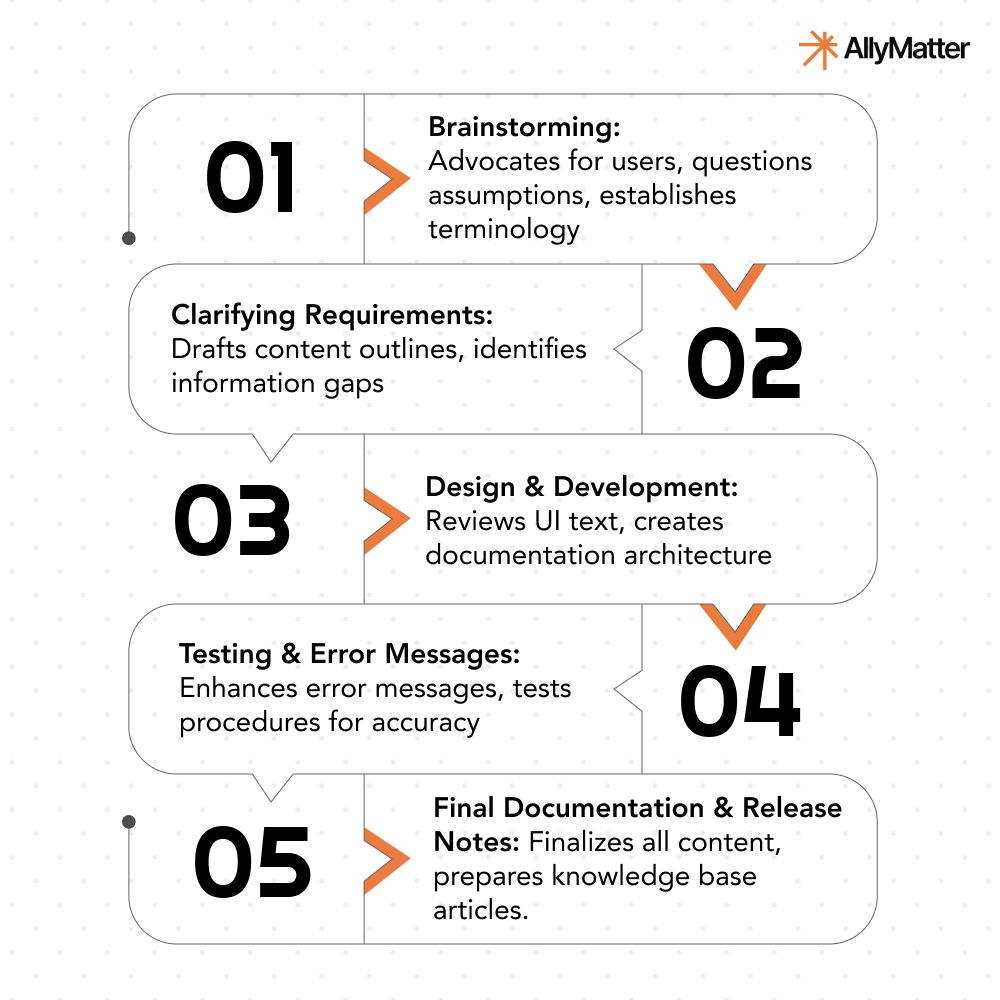Why wait until the end of development to bring in technical writers? Including documentation experts from the start of your engineering process isn’t just a nice-to-have; it’s a strategic advantage that can transform your product development lifecycle.
The traditional documentation dilemma
For too many organizations, technical documentation remains an afterthought – something to be rushed together before release after the “real work” is done. This approach leads to predictable problems: documentation not matching the final product, frustrated users, increased support costs, and burned-out writers trying to understand complex systems under tight deadlines.
But what if there were a better way?
The business case for early documentation involvement
When technical writers participate in early planning meetings and design discussions, they bring a unique perspective that helps identify potential user pain points, clarity issues, and documentation needs before they become costly problems.
Reduced costs: Issues identified early in the design phase are significantly cheaper to fix than those discovered after development. Technical writers often spot usability problems, confusing terminology, or implementation inconsistencies that might otherwise slip through.
Increased efficiency: With writers involved from the beginning, documentation evolves alongside the product rather than being frantically created at the end. This parallel development eliminates the “documentation debt” that often creates bottlenecks before release.
Enhanced user experience: Technical writers are user advocates who constantly ask, “Will this make sense to someone who hasn’t been in our planning meetings?” This perspective often leads to more intuitive interfaces and clearer workflows.
Technical writers as knowledge custodians
Beyond creating end-user documentation, technical writers serve as invaluable knowledge managers throughout the development process.
Organizational memory: How many times has your team asked, “Where are the specs for this feature?” or “Didn’t we discuss this already?” Technical writers excel at organizing internal project documentation, creating and maintaining centralized repositories, and ensuring critical information doesn’t get lost in endless email threads or chat conversations.
As one senior developer put it: “Our technical writer knows where everything is documented. She’s our in-house loremaster.”
Continuous documentation: When writers are integrated into the development process, documentation evolves naturally with each sprint or milestone. Changes are captured as they happen rather than reconstructed weeks or months later. This approach ensures accuracy and dramatically reduces the end-of-project documentation crunch that so often leads to quality issues.
How technical writers enhance the development process
Technical writers bring more to development than just their writing skills:
User advocacy: While engineers and product managers focus on features and functionality, technical writers constantly consider the user’s perspective. They ask the questions users would ask and push for clarity where there might be confusion.
Language precision: Writers help streamline API naming conventions, improve UI labeling, and create consistent terminology across the product. This linguistic consistency makes products more intuitive and reduces the learning curve for users.
Identifying gaps: Good technical writers have a talent for spotting missing information or unexplained functionality. “What happens if the user does X?” or “How does this interact with feature Y?” These questions often uncover edge cases or integration issues early in the development cycle.
Documentation architecture: Just as software needs a solid architecture, so does documentation. Writers can design information structures that will scale with the product and accommodate future expansions without requiring complete reorganization.
Breaking down silos: Writers as cross-functional team members
The most effective technical writing happens when writers are fully integrated into development teams:
Participation in the full lifecycle: From initial brainstorming through design, development, testing, and release, technical writers add value at every stage. They can help clarify requirements, document design decisions, create user-friendly error messages, develop testing scenarios, and prepare release notes; all while building comprehensive documentation.

Cross-team communication: Technical writers often work across multiple teams, giving them a broader perspective on how different components interact. This position makes them valuable connectors who can facilitate knowledge transfer between specialized teams.
Documentation that reflects reality: When writers witness the development process firsthand, they create documentation that reflects how the product actually works; not just how it was intended to work. This accuracy is crucial for user trust and adoption.
Implementing the integrated approach
Bringing technical writers into the early stages of development requires some adjustments:
Team structure: Consider where technical writers fit in your organization. Are they part of engineering teams? Product teams? A separate documentation department? The most successful models usually involve writers being embedded with development teams while maintaining connections to other writers for consistency.
Process integration: Define clear touch points for documentation throughout your development process. Include documentation tasks in sprint planning, feature kickoffs, and review cycles.
Collaboration tools: Ensure writers have access to the same tools as developers – code repositories, issue trackers, design documents, and testing environments. This access is essential to create accurate, timely documentation.
Cultural shift: Perhaps most importantly, foster a culture that values documentation as an integral part of the product, not just an accessory. Recognize that good documentation reflects good design and clear thinking.
The future of technical documentation in product development
As products become more complex and user expectations rise, the role of technical writers continues to evolve:
Documentation-driven development: Some teams are now using documentation as a design tool, writing the user guide before writing code to ensure the product is intuitive and sensible from the user’s perspective.
Integrated documentation tools: Modern development environments increasingly support embedded documentation that lives alongside code, making it easier to keep documentation and functionality synchronized.
Strategic information architecture: Technical writers are becoming information strategists who design holistic knowledge systems spanning multiple formats and platforms – from traditional manuals to interactive guides, videos, chatbots, and embedded help.
How AllyMatter supports integrated documentation workflows
Technical writers working as strategic partners need tools that evolve with the development process, not against it. AllyMatter provides the foundation for documentation-driven development with real-time collaboration capabilities that keep writers connected to engineering decisions as they happen.
The platform’s version control ensures that technical specifications and architectural decisions remain synchronized throughout development cycles. When requirements change or features evolve, writers can track those changes alongside code commits, maintaining accurate documentation that reflects the current state of development.
Smart approval workflows enable technical writers to establish review processes for critical documentation, ensuring that API specifications, user guides, and internal procedures receive proper validation from subject matter experts before release. This systematic approach prevents the documentation gaps that often emerge when writers are brought in at the project’s end.
With granular access control, growing teams can organize project documentation hierarchies that match their development structure, giving technical writers the organizational framework needed to serve as effective knowledge custodians across multiple teams and projects.
Documentation as a strategic advantage
Good documentation isn’t just about explaining what you built; it’s also about building something worth explaining. By including technical writers from the beginning of your development process, you gain not only better documentation but also better products, more efficient teams, and happier users.
Technical writers aren’t just scribes who record what engineers have created; they’re strategic partners who help shape products that are clear, consistent, and user-focused. In a world where user experience often determines market success, that partnership isn’t just nice to have; it’s a competitive necessity.
Remember: The best time to involve technical writers isn’t at the end of development. It’s at the beginning.
Transform your technical writing workflow from reactive to strategic. Join our waitlist to discover how AllyMatter supports integrated documentation from day one.
Frequently asked questions
When should we bring technical writers into our development process?
The optimal time is during initial project planning, not after development is complete. Technical writers add the most value when they participate in requirements gathering, design discussions, and sprint planning. This early involvement helps identify documentation needs, clarify user workflows, and establish consistent terminology before development begins.
How do technical writers fit into agile development cycles?
Technical writers integrate seamlessly into agile workflows by participating in sprint planning, daily standups, and retrospectives. They can work on documentation tasks alongside development sprints, creating user stories for documentation needs, and maintaining living documentation that evolves with each iteration.
What’s the ROI of including technical writers early in development?
Early integration reduces costs by catching usability issues and inconsistencies before they require expensive fixes. It also eliminates documentation debt, reduces post-release support tickets, and improves user adoption rates. The investment in early writer involvement typically pays for itself through reduced rework and faster user onboarding.
Do technical writers need access to development tools and environments?
Yes, technical writers need access to the same tools developers use – code repositories, issue trackers, design documents, and testing environments. This access ensures they understand the product deeply and can create accurate, comprehensive documentation that reflects the actual user experience.
How can we measure the impact of integrated technical writing?
Track metrics like documentation accuracy scores, user onboarding completion rates, support ticket reduction, and time-to-release for documentation. Also monitor qualitative feedback from development teams about communication clarity and knowledge transfer effectiveness.


